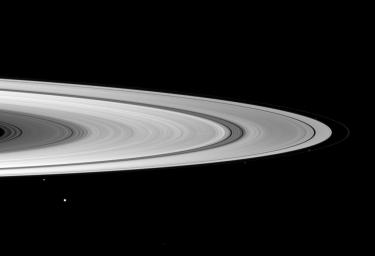"It's full of stars!" the character Bowman proclaimed in 2001: A Space Odyssey. This Cassini spacecraft view evokes the exclamation, "It's full of moons!"
Saturn possesses no less than 52 officially named satellites. Nine of them crowd around the ring system in this image, though some are too faint to see.
Starting in the lower left, Mimas (396 kilometers, or 246 miles across) appears largest and closest to the viewer. Janus (179 kilometers, or 111 miles across) is also in the lower left but is closer to the rings. Following the edge of the rings toward the right of the image, Pandora (81 kilometers, or 50 miles across) is below center-right, outside the rings. One of the shepherds of the F ring—Prometheus (86 kilometers, or 53 miles across) —can be seen on the far right of the image, just inside the faint F ring. Atlas (30 kilometers, or 19 miles across) is also on the far right, above the horizontal center of the image. It has been brightened to make it visible.
Those with a careful eye may be able to see Pan (28 kilometers, or 17 miles across) cutting through the thin black line of the Encke Gap. Pan and Helene have both been brightened to make them visible, but they each only comprise one pixel in the image. Helene (33 kilometers, or 21 miles across) is located at the bottom of the image, to the left of the vertical center.
Daphnis (8 kilometers, or 5 miles across) and Pallene (4 kilometers, or 3 miles across) are present in this view but are not visible at this resolution.
The image was taken with the Cassini spacecraft wide-angle camera on Dec. 13, 2008 using a spectral filter sensitive to wavelengths of infrared light centered at 918 nanometers.The view was obtained at a distance of approximately 1.181 million kilometers (734,000 miles) from Saturn and at a Sun-Saturn-spacecraft, or phase, angle of 26 degrees. Image scale is 67 kilometers (42 miles) per pixel.
The Cassini-Huygens mission is a cooperative project of NASA, the European Space Agency and the Italian Space Agency. The Jet Propulsion Laboratory, a division of the California Institute of Technology in Pasadena, manages the mission for NASA's Science Mission Directorate, Washington, D.C. The Cassini orbiter and its two onboard cameras were designed, developed and assembled at JPL. The imaging operations center is based at the Space Science Institute in Boulder, Colo.
For more information about the Cassini-Huygens mission visit http://saturn.jpl.nasa.gov/. The Cassini imaging team homepage is at http://ciclops.org.

 Planetary Data System
Planetary Data System












